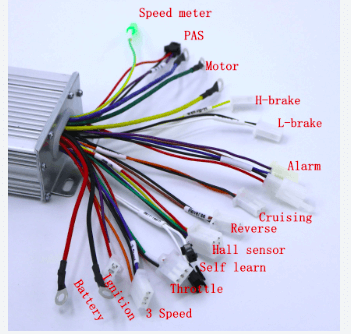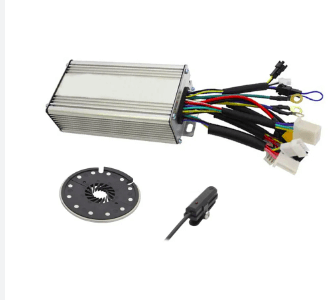
How do ebike controllers work?
ebike controllers.
E-bike controllers are devices that control the power output of an electric bike’s motor. They typically consist of a control unit, which is connected to the bike’s battery, and a throttle or pedal-assist sensor, which detects the rider’s input.
How do ebike controllers work?
When the rider turns on the e-bike and starts pedaling, the controller receives a signal from the throttle or pedal-assist sensor and begins to supply power to the motor. The controller can be adjusted to provide different levels of assistance, depending on the rider’s needs. For example, it can be set to provide a low level of assistance for a leisurely ride or a high level of assistance for climbing steep hills.
The controller also monitors the battery’s state of charge and regulates the amount of power supplied to the motor to ensure that the battery does not become over-discharged. It also has safety features like overcurrent protection, overvoltage protection and short circuit protection.
In summary, an e-bike controller is an essential component of an electric bike system, it controls the power output of the motor and regulates the battery to ensure safe operation of the e-bike.
What is incorporated within an ebike controller?
An e-bike controller is a piece of electrical equipment that regulates the power output of an electric bike’s motor. The following components are commonly found within an e-bike controller:
Microcontroller:
This is the controller’s brain; it analyses sensor data and controls the motor’s power output. Memory and communication interfaces are also included.
Electronic power switches:
These are the electrical components that regulate the power flow from the battery to the motor. They can be constructed from MOSFETS, IGBTs, or other power electronic switches.
Power protection circuits safeguard the controller and the motor from overcurrent, overvoltage, and undervoltage.
Sensors for motor phase current:
These sensors monitor the motor’s performance and safeguard it from overheating or damage by measuring the current flowing through the motor phase wires.
Voltage controller:
This component controls the voltage from the battery to the controller to ensure that it is at the proper level for the controller and motor.
Interfaces for communication:
These interfaces enable the controller to connect with external devices such as the display and thumb throttle. They might be UARTs, CANs, or other communication interfaces.
Inductors and capacitors:
These components are responsible for smoothing the current flowing through the controller and protecting it from voltage spikes.
Transistors and diodes:
These components are utilized to guide the flow of current and protect the controller against reverse voltage.
How do you program an ebike controller?

Programming an e-bike controller might differ based on the controller’s brand and model, as well as the software utilized. However, here are some general procedures for programming an e-bike controller:
Collect the following tools:
A computer, a USB cable, and the programming software for your specific e-bike controller are required.
Connect the controller to the computer: Connect the e-bike controller to the computer using the USB cord.
Install the programming software as follows:
Install the program on your computer and set it up according to the manufacturer’s instructions.
Start the software:
Open the programming software on your computer and choose the proper controller choices.
Change the settings as follows:
Adjust the controller’s parameters using the software, such as the speed limit, power output, assist level, and so on.
Save the configuration:
Once you’ve done all of the required changes, save the settings to the controller.
Disconnect the controller from the computer and test it on the e-bike to confirm that all of the settings are right.
It’s crucial to remember that the instructions and settings may differ depending on the brand and type of the e-bike controller, so if you’re unsure how to proceed, consult the controller’s handbook or take the bike to a specialist.
Also, use caution when handling the e-bike controller, since it may contain high voltage and can be deadly if not handled correctly.
How do i know if my ebike controller is bad?

There are a few signs that can indicate that an e-bike controller is malfunctioning or has failed:
- No power: If the bike does not provide power when the throttle is engaged or if the assist level does not work, the controller may be malfunctioning.
- Inconsistent power: If the power output of the motor is inconsistent or if the bike’s speed is not consistent, the controller may be malfunctioning.
- Error messages: Some e-bike controllers have a display that can show error messages. If the controller is displaying an error message or if the display is not working, the controller may be malfunctioning.
- Unusual noise: Some e-bike controllers can make unusual noise, such as buzzing or whining. This could indicate a problem with the controller.
- Overheating: If the controller or the motor gets too hot to touch, this could indicate a problem with the controller or the motor.
- No response: If the controller does not respond to the rider’s input, this could indicate a problem with the controller.
If any of these signs are present, it’s recommended to take the bike to a professional for further diagnosis and repair. It’s also important to keep in mind that there might be other reasons for these symptoms, and it’s not always the controller that is at fault.
How do I test my ebike controller with meter?
A multimeter and some basic electrical understanding are required to test an e-bike controller using a meter. Here are the actions to take:
Set the multimeter to measure direct current voltage.
Examine the voltage at the power input terminals of the controller. This should be the same as the battery voltage on the bike. If the voltage is lower than predicted, there may be an issue with the battery or the charging mechanism.
Examine the voltage at the output terminals of the controller. This should be the same as the voltage at the input terminals; otherwise, the controller may be faulty.
Examine the resistance between the input and output terminals of the controller. This should be extremely low, suggesting that the connection is strong. A high resistance might suggest a problem with the controller or the wiring.
Examine the continuity of the Hall sensor wires on the motor and the controller. If the continuity is not there, the hall sensors or wires may be destroyed.
If the controller is not reacting to the throttle input, the continuity of the throttle wires may be disrupted or the wires may be damaged.
It is crucial to remember that this is only a basic instruction, and the precise procedures may differ based on the individual e-bike controller and bike model. If you are unsure how to proceed, you should review the e-bike controller’s instructions or take the bike to an expert. Also, use caution when handling the e-bike controller, since it may contain high voltage and can be deadly if not handled correctly.
What are hall sensors on ebikes and how do they work?

Hall sensors are electronic devices that are used in e-bikes to measure the position and speed of the bike’s motor. They are typically located on the bike’s motor and on the controller, and they use the principle of the Hall Effect to measure the rotational position and speed of the motor.
What Is The Hall Effect?
The Hall Effect is a phenomenon that occurs when a magnetic field is applied to a conductor, it causes a voltage difference to develop across the conductor. Hall sensors use this effect to measure the position and speed of the motor by detecting the magnetic field generated by the motor’s rotor.
What do hall sensor consist of?
Hall sensors consist of a small sensor that contains a semiconductor material and a magnet. The sensor is positioned near the rotor of the motor, so that the magnetic field generated by the rotor can be detected. As the rotor rotates, the magnetic field passing through the sensor generates a small voltage, which is then processed by the controller to determine the position and speed of the rotor.
Uses of hall sensors in ebikes
Hall sensors are used in e-bikes to provide precise control of the motor, and to ensure that the motor is providing the correct amount of power to the bike at all times.
They help to provide a more efficient and smooth riding experience, by allowing the controller to adjust the power output of the motor based on the position and speed of the rotor.
They also help to protect the motor and the controller by detecting any problems with the rotor, such as a broken magnet, which can cause the motor to fail.
You might be interested in:






